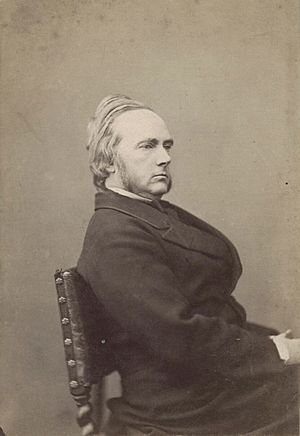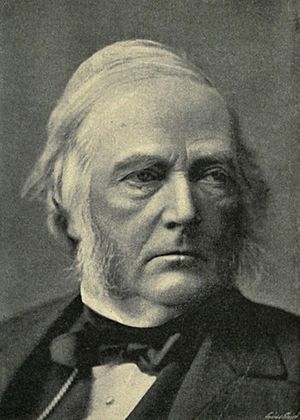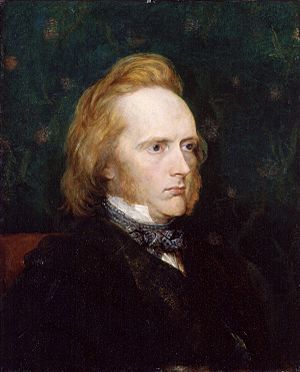George Campbell, 8th Duke of Argyll facts for kids
Quick facts for kids
The Duke of Argyll
|
|
|---|---|

Portrait by Herbert Rose Barraud, c. 1870-75
|
|
| Lord Privy Seal | |
| In office 4 January 1853 – 7 December 1855 |
|
| Monarch | Victoria |
| Prime Minister | The Earl of Aberdeen The Viscount Palmerston |
| Preceded by | The Marquess of Salisbury |
| Succeeded by | The Earl of Harrowby |
| In office 18 June 1859 – 26 June 1866 |
|
| Monarch | Victoria |
| Prime Minister | The Viscount Palmerston The Earl Russell |
| Preceded by | The Earl of Hardwicke |
| Succeeded by | The Earl of Malmesbury |
| In office 28 April 1880 – 2 May 1881 |
|
| Monarch | Victoria |
| Prime Minister | William Ewart Gladstone |
| Preceded by | The Duke of Northumberland |
| Succeeded by | The Lord Carlingford |
| Postmaster General | |
| In office 30 November 1855 – 21 February 1858 |
|
| Monarch | Victoria |
| Prime Minister | The Viscount Palmerston |
| Preceded by | The Viscount Canning |
| Succeeded by | The Lord Colchester |
| Secretary of State for India | |
| In office 9 December 1868 – 17 February 1874 |
|
| Monarch | Victoria |
| Prime Minister | William Ewart Gladstone |
| Preceded by | Sir Stafford Northcote, Bt |
| Succeeded by | The Marquess of Salisbury |
| Personal details | |
| Born | 30 April 1823 Ardencaple Castle, Dunbartonshire |
| Died | 24 April 1900 (aged 76) Inveraray Castle, Argyll |
| Nationality | British |
| Political party | Liberal |
| Spouses |
Amelia Claughton
(m. 1881; died 1894)Ina McNeill
(m. 1895) |
| Children | 12, including John, Colin, Victoria and Frances |
| Parents |
|
| Signature |  |
George Campbell, 8th Duke of Argyll (born April 30, 1823 – died April 24, 1900) was an important British leader and thinker. He was known as a polymath, which means he was an expert in many different subjects. He was a member of the Liberal Party and served in several high-ranking government jobs.
The Duke of Argyll was also a keen scientist. He made a big discovery in the 1850s when fossilized leaves were found on the Island of Mull. He also helped people learn more about ornithology, the study of birds. He was one of the first to explain how birds fly, hoping it would help create flying machines. He wrote many books and articles on science, religion, money, and politics. He worked with important Prime Ministers like William Ewart Gladstone.
Contents
Early Life and Family
George Campbell was born at Ardencaple Castle in Scotland. He was the only surviving son of the 7th Duke of Argyll, John Campbell. When his father passed away in 1847, George became the 8th Duke of Argyll. This also meant he took on important family roles, like being the hereditary Master of the Household of Scotland.
Political Career and Public Service
Even before he became Duke, George Campbell was known for his writings on important topics, like changes in the Church of Scotland. He quickly became a leading voice for the Liberal Party in Parliament. He was a great speaker in the House of Lords, which is part of the British Parliament.
He held several key government positions:
- Lord Privy Seal: He served as Lord Privy Seal twice (1852-1855 and 1859-1866). This role involved advising the monarch and looking after the King's or Queen's private seal.
- Postmaster General: From 1855 to 1858, he was in charge of the postal service.
- Secretary of State for India: From 1868 to 1874, he oversaw British rule in India.
During the American Civil War, he strongly supported the Northern states.
Improving Education in Scotland
The Duke of Argyll played a very important role in improving schools in Scotland. In 1866, he led a group called the Argyll Commission. They studied the Scottish school system and found it needed a lot of help. Their report, finished in 1869, pushed for major changes. Because of his efforts, the Education Act (Scotland) of 1872 was passed. This law made primary school education compulsory for children aged 5 to 13 in Scotland.
He also helped create the Royal Indian Engineering College. This college trained engineers to work in India. In 1871, his son, Lord Lorne, married Princess Louise, one of Queen Victoria's daughters. This marriage further increased the Duke's standing in society.
Later Political Life
In 1880, he again served as Lord Privy Seal. However, he resigned in 1881 because he disagreed with a new law about land. He felt it would harm the rights of landowners. Later, in 1886, he completely broke away from Prime Minister Gladstone over the issue of Irish Home Rule, which was about giving Ireland more control over its own affairs.
The Duke of Argyll also held honorary positions, like Lord Lieutenant of Argyllshire, from 1862 until his death. He received high honors, becoming a Knight of the Thistle in 1856 and a Knight of the Garter in 1883. In 1892, he was given the title of Duke of Argyll in the Peerage of the United Kingdom.
Scientific Interests and Contributions
The Duke of Argyll was a dedicated amateur scientist. He studied many different fields, including:
- Ornithology: He was very interested in birds and how they fly.
- Geology: He studied the Earth's rocks and landforms. He even served as President of The Geological Society from 1872 to 1874.
- Evolution: While he believed in evolution, he disagreed with some of Charles Darwin's ideas. He thought that evolution was guided by a divine power, a view called "theistic evolution."
- Economics: He wrote about how societies manage their money and resources.
He was elected a Fellow of the Royal Society in 1851, which is a very prestigious scientific group. He also served as Chancellor of the University of St Andrews and Rector of the University of Glasgow. He was president of the Royal Society of Edinburgh and the British Association for the Advancement of Science.
In 1866, he helped start Britain's first society for flight, the Aeronautical Society of Great Britain. He was its president for many years, from 1866 to 1895.

Personal Life
The Duke of Argyll was married three times. His first wife was Lady Elizabeth Leveson-Gower, whom he married in 1844. They had twelve children together, including five sons and seven daughters. Some of their notable children were John, Colin, Victoria, and Frances.
After Lady Elizabeth passed away in 1878, he married Amelia Maria in 1881. She died in 1894. In 1895, he married Ina McNeill. He did not have any children from his second or third marriages.
The Duke of Argyll died at Inveraray Castle in April 1900, just before his 77th birthday. He was buried at Kilmun Parish Church. His eldest son, John, became the 9th Duke of Argyll.
Legacy
A road in Penang, Malaysia, called Argyll Road, is named in his honor.
Key Works
The Duke of Argyll wrote many important books and articles, including:
- The Reign of Law (1867)
- Primeval Man: An Examination of some Recent Speculations (1869)
- The Eastern Question (1879)
- The Unity of Nature (1884)
- Scotland As It Was and As It Is (1887)
- The Unseen Foundations of Society (1893)
- Organic Evolution Cross-Examined (1898)
- Autobiography and Memoirs (published after his death in 1906)



